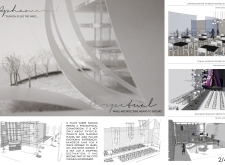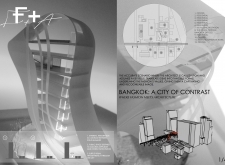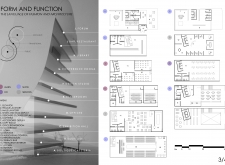5 key facts about this project
### Project Overview
Located in Bangkok, Thailand, the Fashion and Architecture Center presents a strategic architectural design that explores the intersection of fashion and built environment. The project conceptually juxtaposes the fleeting nature of fashion with the permanence of architecture, aiming to create a dynamic space for cultural and commercial interactions. This center will engage both local and international communities in a city that is recognized for its vibrant fashion scene.
### Spatial Organization
The layout comprises various interconnected zones, including a bar/restaurant, library, design studios, classrooms, and exhibition spaces, facilitating both collaborative and individual activities. A runway area and forums are integrated to support events central to the fashion industry, merging public and private spaces to foster an interactive experience for visitors. The carefully defined areas enable smooth transitions while encouraging engagement among users.
### Material and Sustainability Strategies
The architectural form features a spiraling structure that embodies motion, utilizing both transparent and opaque materials to enhance visual connections with the surroundings. Key materials include acrylic and glass for their light-permeable qualities, complemented by a steel framework ensuring structural stability. Warm wood accents bring a sense of comfort to the interior environments, which are designed to serve multiple purposes through flexible configurations. Sustainable practices are incorporated, such as rainwater harvesting systems and roof designs that effectively manage stormwater, aligning with current environmental standards while nurturing a sustainable operational framework.






















































